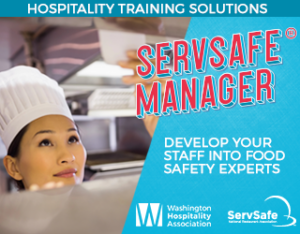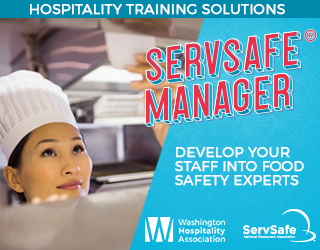The Washington State Department of Labor has released its new outdoor heat exposure rules. The final rule was filed on June 27, but enforcement will not take place until July 17. You can read the complete rules here. These new rules will be enforced year-round whenever workers are exposed to outdoor heat. Make sure that you include an outdoor heat exposure safety program in your Accident Prevention Plan (APP) and train your team on the new policies. You can find a training program from L&I here.
Employees who are subject to these rules include, but are not limited to:
- Employees who serve or assist guests outside
- Catering employees
- Golf course employees
- Pool attendants
A heat-related illness includes, but is not limited to:
- Heat cramps
- Heat rash
- Heat exhaustion
- Fainting
- Heat stroke
What’s new & what you need to know
Timeline
The updated heat rules were adopted on June 27 and take effect immediately. They will be in place year-round. (Previous heat rules were only enforced May-Sept.) L&I will delay enforcement of the new heat rules until July 17.
Action items: Review the new heat rules and ensure you are in compliance with the new rules by July 17. Contact your territory manager if you have any questions about the new heat rules.
Outdoor safety plan
Make sure that you include an outdoor heat exposure safety program in your Accident Prevention Plan (APP). Your outdoor heat exposure safety plan must include, at a minimum:
- Procedures for providing sufficiently cool drinking water
- Procedures for providing shade or other options for employees to cool down
- Emergency response procedures for employees demonstrating signs or symptoms of heat-related illness
- Acclimatization methods and procedures
- High heat procedures
- How you plan to observe employees for signs and symptoms of heat-related illness closely
Action items: Update your Accident Prevention Plan to include these new requirements if they are not in your plan already.
Employee training
Under the old rules, employers would be required to train employees only when employees were about to work outdoors in warm temperatures. Under the new heat rules, employers are required to train all outdoor employees on the new heat rules and best practices to prevent heat-related illnesses and injuries.
Action items: Training materials and other heat-related safety information must be provided in a language the employee understands.
L&I has updated resources on its website that include training materials.
Excessive heat & cool-down breaks
Allowing the body to rest is a critical prevention measure in high heat.
Action items: When employees work outside and temperatures reach 90 degrees or higher, employers are required give employees a 10-minute cool-down break every two hours. When temperatures are at 100 or above, employees must receive a 15-minute break every hour. The mandatory cool-down rest period may be provided concurrently with any meal or rest period required under WAC 296-126-092 and must be paid unless taken during a meal period.
|
Air Temperature |
Mandatory cool-down rest periods |
| At or above 90°F | 10 minutes/2 Hours |
| At or above 100°F | 15 minutes/1 hour |
Rising temperatures & drinking water
Employers who have employees who work outdoors must provide sufficiently cool, potable water and access to shade to reduce body temperature during a heat-related illness. Employers must provide at least one quart of water per employee per hour and give each employee time to drink it.
Having shade available to block direct heat from the sun helps workers cool down during meal or rest periods. Alternatives to shade may include misting stations, cooling vests or air-conditioned areas.
Action items: These rules go into effect at 52 degrees Fahrenheit if the employee wears personal protective equipment or other non-breathable clothing. For all other employees, these rules apply when the temperature reaches 80 degrees.
Employers must have an effective communication system in place that allows employees to report signs of heat-related illnesses.
Have emergency response plans in place for anyone demonstrating symptoms of a heat-related illness. You should encourage your employees to frequently drink water or other acceptable beverages that don’t contain high levels of sugar or caffeine.
You should encourage your employees to take frequent cooling breaks to protect themselves from overheating. Employees are responsible for monitoring their own personal factors for heat-related illness, including consumption of water or other acceptable beverages to ensure hydration and taking preventative cool-down rest periods when they feel the need to do so to prevent overheating.
Acclimatization
Workers are at higher risk of heat-related illness if they are not acclimated or used to the heat. Acclimatization takes 7–14 days to develop and can be lost after seven days from working in the heat. A sudden increase in temperature does not allow time for workers to acclimate.
Action items: If your employee hasn’t been acclimated to the heat, you should observe them closely for heat-related symptoms for 14 days. These employees include new employees, those returning from absences and all workers during a heat wave. Close observation includes regular communication with employees working alone by radio or cell phones. Use the buddy system or other means of observation.
If you have questions about these new rules, please get in touch with a consultant from L&I. You can find a consultant in your county here.
Information and Training:
Complete Heat Illness Training Kit
L&I: Training Kits
L&I: Proposed changes to outdoor heat exposure rules
L&I: Frequently asked questions



















![Webinar replay! [Ask a Lawyer] Best hiring practices](https://wahospitality.org/wp-content/uploads/2024/05/CatherineHiring-webinar-150x150.png)









